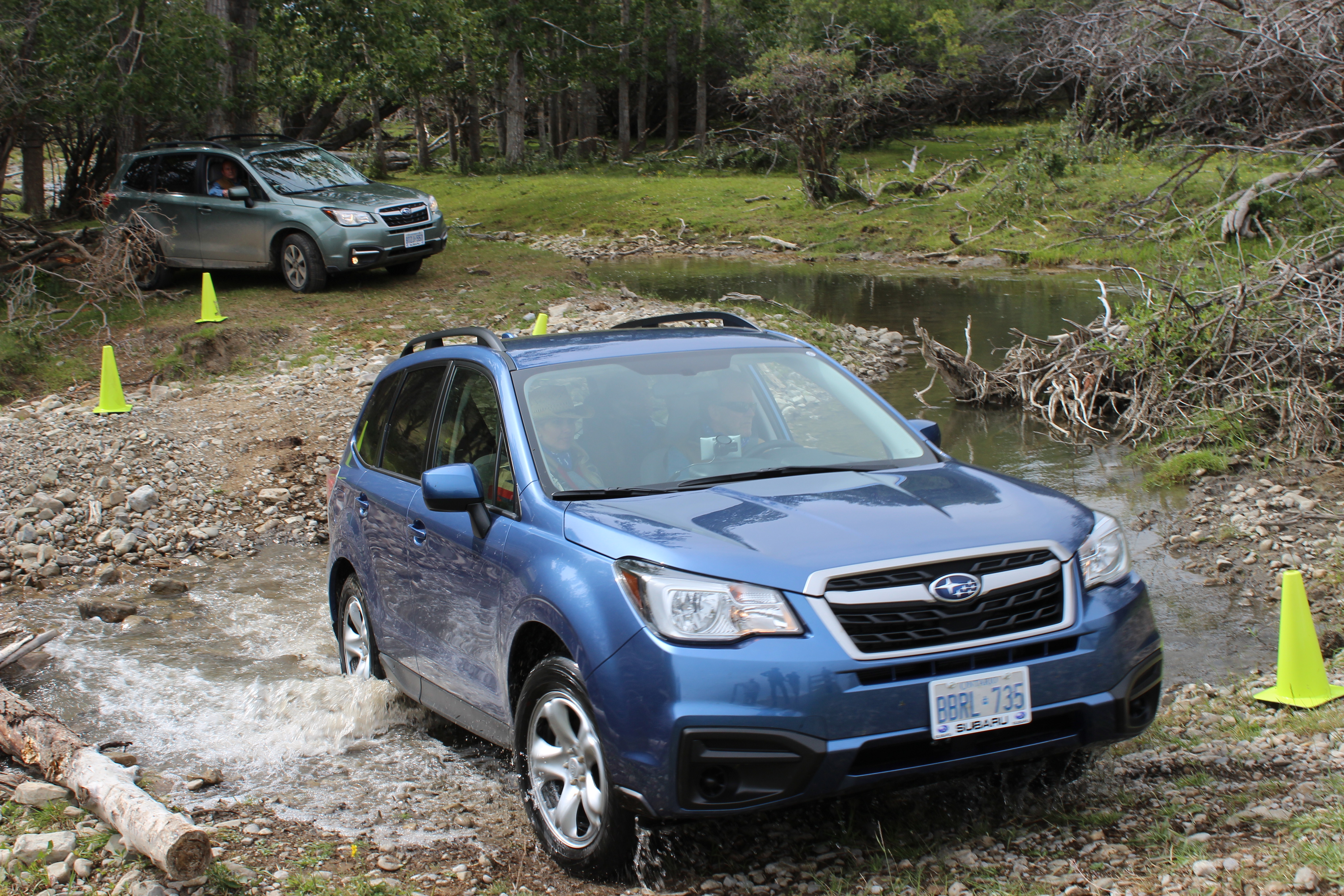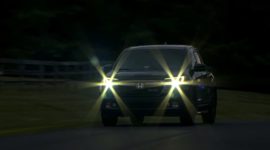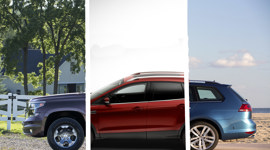While Subaru has enjoyed recent success over the last few years – 2015 saw their Canadian sales figures almost triple those of 2005 – it’s interesting to look at why they’ve seen their popularity increase as it has in recent years.
It isn’t about their looks, that’s for sure; with the exception of the BRZ sports car, everything they build has this aura of butchness about it. The latest Outback wagon with its plastic cladding, high ride height and chunky details looks unlike most anything on sale in Canada today, especially if we’re talking about station wagons in particular, which tend to gravitate to sleek European brands with sleek, luxurious styling. The WRX STI sedan? With the loss of the Mitsubishi Lancer EVO after 2015, nothing comes close. And even the Mitsu was easier on the eyes.
Which brings us to the facelifted 2017 Subaru Forester CUV you see here. Even with new details like LED headlights, a redesigned grille and a selection of more aerodynamic two-tone wheel choices, stuff like the Hyundai Tucson, Honda CR-V and even the recently redesigned Toyota RAV4 cut a more stylish swathe through the mass-consumption compact crossover landscape.
The theme continues inside. Yes, Subaru has made some great strides with their interior detailing over the last few years, starting with the Legacy sedan. Better infotainment, a nod to a little more curves here, and a few more soft-touch materials there are all welcome additions but I still wouldn’t say that’s what Subies are about.
Still, the Forester has made up a third of all Subarus sold each year since 2014 (and up to the time of writing for 2016, too), so people seem to be able to overlook the stylistic bugaboos.

So what, then? Well, I had a eureka moment when I realized that with that Legacy, Canadians could get an all-wheel-drive mid-size sedan for under 25 grand. That is huge. In a country that gets mostly buried in snow for five months of the year, that peace of mind cannot be replaced. That’s the ticket, and ever since the ’80s, Subaru has ridden the AWD wave to where it sits now.
Of course, AWD is great in a sedan, but for many, it’s an absolute must in SUVs and crossovers like the Forester.
“(The Forester’s Symmetrical AWD tech) is a differentiating factor (for buyers),” says Anton Pawczuk, director of product management and sales training at Subaru Canada. “A lot of people have cottages and they always talk about that one snow storm, or that one road, or that one place they tried to go, but had trouble.”
“It’s the idea that the Forester can do all that stuff that other SUVs can do, but there’s that peace of mind in case you need it.”
The cottage is one thing, but since such a large portion of Forester buyers are in the 30–39 age bracket, the Forester will have to be able to tackle nature’s unpaved backroads on the way to the canoe or hiking spot in the dead of summer.
So, what do you do if you’re Subaru, and eager to show off to a group of car scribes what years of AWD experience can do? Well, you take them off-roading, of course!
So, off-road we went. We’re not talking a little gravel work just off the beaten track, here. We’re talking rutted mud paths, wet, grassy climbs and foraging through shale so sharp you’d think you were on a stage of the Greek round of the World Rally Championship. When the circuit used to pass through there, that is.

We weren’t in Greece, though. We were in the Canadian Rockies just outside of Calgary, AB, but rest assured: there was plenty here to put the ’17 Forester to the test. Recent rains, meanwhile, meant a double-down on the challenge presented by these roads.
As is the case with all AWD Subarus, all four of the Forester’s wheels receive power at any given time. It’s not a reactionary system that sends power to the back only when you need it; they’re always getting some of the juice. It starts out as a 60:40 front-rear split if you have the continuously-variable automatic transmission, with the possibility of a 50:50 split should the conditions require it. Manual cars – yes, you can still get a Forester with a clutch pedal, which is unique to the segment – are locked at 50:50. That’s not all; torque can be split at either axle, so if a left-side tire loses traction, 100% of the available torque can be sent to the opposite side to clean up the mess.
It’s the controlling of the Forester’s yaw movements in adverse conditions that really impresses. Just when you think you’re about to lose it all, the system steps in and rights the ship, subtly sending power to whichever wheel needs it to get things back on-line.
The system’s reactions are magnified if you’ve selected “X-Mode”, which comes as standard on all Forester trims. It decreases the system’s reaction times to provide even more confidence, and also automatically activates a hill-descent-control system.

Unlike other hill-descent systems, the Forester’s is pre-set; it’s not up to you to select which speed you want to push forwards at. A problem? Maybe if you were a hardcore off-roader, but as good as it was in the conditions we had, that’s not what the Forester is. Plus, the 20 km/h it does keep you at is plenty.
Other than the speed thing, the Forester’s hill-descent system works as advertised. It makes clever use of the clutches and transmission to keep you pushing comfortably ahead, without your feet on the pedals. All you have to do is keep your hands on the wheel (which you have to be a little more cautious with, as the steering ratio has been increased for 2017, meaning smaller wheel inputs provide increased response) and let the system do the rest. It’s a bit eerie at first as the mechanical grip arrives fairly suddenly, but we got over that pretty quick. Going uphill, however, is up to the driver as there’s no hill-ascent control available. That’s all on the driver.
Which is not so much of an issue when you consider just how well-sorted the Forester is. As we plowed through mud-soaked trails around the Frank Slide in the tiny former mining town of Bellevue, AB, we had the chance to test the Forester on exactly the kind of stuff Pawczuk was talking about: those roads that you may only venture on a couple of times a year on the way up to the cottage, but are challenging surface-wise to the point where you’re happy you have the Forester and its 220 mm of ground clearance. Which, of course, is best in class.
It’s quite something to feel the Forester and its Bridgestone Dueler H/T all-season tires scratch and claw as we plowed – yes, “plowed” is the right word – through the muck. We’re not talking easy straight-shots either; we were in the Rockies, remember, and the elevation changes came thick and fast, accompanied by a hairpin turn here and a deep puddle there. Driven gently and without too much provocation, the Forester took it all in stride.
Mud thick as mortar that we thought would surely lead to wheelspin if not a total bogging-down of the powertrain lead to no such thing; there’s not even that need to concern yourself with the lack of momentum your cautious progress may be making. Symmetrical AWD just decides where it needs to send the power, does so, and basically winches you out of any situation.

On light gravel surfaces where speeds can get a little higher, the Symmetrical AWD is once again there to quietly keep you on the straight and (often quite) narrow. Gravel roads are a bit of a false-confidence thing, especially after driving the slick, muddy roads we had been on. While they look like a super-highway compared to that much, you’re still on very loose terrain, as evidenced by the way you can feel the Forester constantly adjusting beneath you if you begin to push it too far. Which comes a lot sooner than you may think. It’s times like these where you’re really happy to have all those gearsets and diffs working beneath you. I guess the one criticism I have is that the Symmetrical AWD, coupled with standard traction control (that can never be fully switched off), is always quick to step in should you fancy some tail-out amateur rallying hijinks on a wide gravel road that you’re familiar with. Which, of course, isn’t really a criticism at all. If that’s what you want, go and get yourself a WRX or WRX STI.
The same goes for our sojourn around the massive Frank Slide rockslide that buried a portion of Frank, AB in 1903. While the higher speeds we’d been travelling in the finer gravel put the AWD to the test, here, slower speeds but a steeper and more uneven surface were the challenge. It was in these conditions that we did feel a little bit of wheelspin, but it was a minor event, quickly snuffed out. It took everything we were throwing at it, this Forester. It really did.
If you want a vehicle that will safely get you to the cottage or your favorite back-country playground without incident, the Forester has to be considered. After all, who cares about looks when you’re caked in mud or chalky dust?





















